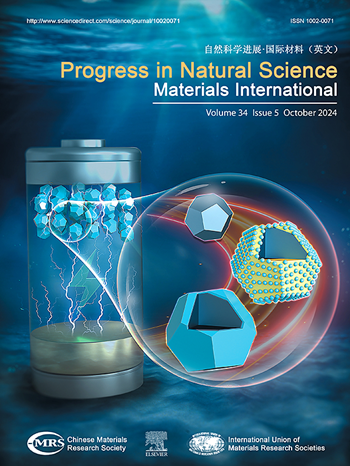Nickel-based cathode in the rechargeable aqueous zinc ion batteries
IF 7.1
2区 材料科学
Q2 MATERIALS SCIENCE, MULTIDISCIPLINARY
Progress in Natural Science: Materials International
Pub Date : 2025-04-01
DOI:10.1016/j.pnsc.2024.11.003
引用次数: 0
Abstract
In order to reduce reliance on fossil energy sources, there has been a focus on developing and utilizing the new renewable energy sources, leading to the gradual development of electrochemical energy storage systems. Among these systems, the rechargeable aqueous zinc ion battery has emerged as one of the most promising for commercialization in the next generation, receiving extensive research attention since its inception. A specific type within this category is the aqueous nickel-zinc battery, which utilizes a nickel-based electrode as the cathode and zinc as the anode, offering researchers a high capacity option. However, as research progresses, limitations of using solely nickel-based materials have become apparent, such as poor stability. To address these issue, various modification studies have been conducted, yielding some promising results. To provide a comprehensive overview of the design of cathode materials for aqueous zinc ion batteries, this review summarizes recent research and outlines the preparation method, modification techniques, and enhancement mechanisms of nickel-based materials.
可充电水性锌离子电池中的镍基阴极
为了减少对化石能源的依赖,开发和利用新的可再生能源成为人们关注的焦点,电化学储能系统也逐渐发展起来。在这些系统中,可充电水性锌离子电池已经成为下一代最有商业化前景的系统之一,自问世以来就受到了广泛的研究关注。这一类中的一种特殊类型是含水镍锌电池,它利用镍基电极作为阴极,锌作为阳极,为研究人员提供了高容量的选择。然而,随着研究的深入,单纯使用镍基材料的局限性也越来越明显,比如稳定性差。为了解决这些问题,进行了各种改性研究,取得了一些有希望的结果。本文对锌离子电池正极材料的设计进行了综述,综述了镍基材料的制备方法、改性技术和增强机理。
本文章由计算机程序翻译,如有差异,请以英文原文为准。
求助全文
约1分钟内获得全文
求助全文
来源期刊
CiteScore
8.60
自引率
2.10%
发文量
2812
审稿时长
49 days
期刊介绍:
Progress in Natural Science: Materials International provides scientists and engineers throughout the world with a central vehicle for the exchange and dissemination of basic theoretical studies and applied research of advanced materials. The emphasis is placed on original research, both analytical and experimental, which is of permanent interest to engineers and scientists, covering all aspects of new materials and technologies, such as, energy and environmental materials; advanced structural materials; advanced transportation materials, functional and electronic materials; nano-scale and amorphous materials; health and biological materials; materials modeling and simulation; materials characterization; and so on. The latest research achievements and innovative papers in basic theoretical studies and applied research of material science will be carefully selected and promptly reported. Thus, the aim of this Journal is to serve the global materials science and technology community with the latest research findings.
As a service to readers, an international bibliography of recent publications in advanced materials is published bimonthly.

 求助内容:
求助内容: 应助结果提醒方式:
应助结果提醒方式:


